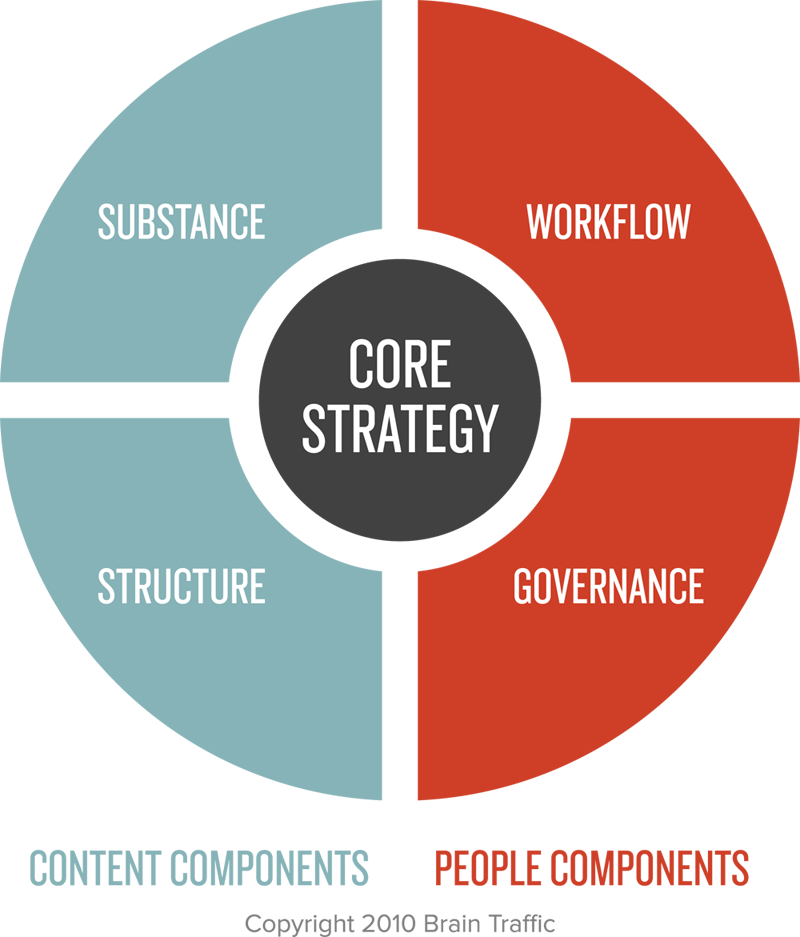You know you need a content strategy. But what does one actually look like?
There isn’t a single, simple formula, although there are some key elements and tools to bear in mind to help build and implement that strategy.
This post and the related What a content strategy can do for you is really a result of realising that we don’t have a content strategy, and that most of the problems encountered by our website might be a result of not having one.
Core strategy
What are you trying to achieve with your content?
A core strategy should be something memorable and aspirational. It should focus on what people ultimately want to get done as a result of using your content.
At a university someone’s aspiration might be “start a great career in research” or “develop myself as a person“. For the business the aspiration might be “become a global centre of research excellence“.
If you don’t have the bigger picture in mind you’ll never get the detail right.
People
How is content agreed on, produced, and maintained? For people, a strategy should address:
- Workflow. Processes and tools. You should have a cycle of creation, maintaining, and evaluation. How will this work in practice? Will you need different workflows for different teams?
- Governance. How are key decisions about content and content strategy made?
- Ownership. Tying workflow and governance together. Everyone needs to know what their role is and how it fits into the overall process. People really respond if they can see clearly where they fit into a bigger picture.
Content
What sort of content are we using, and how is it organized? For content, a strategy should address:
- Who. Who are you trying to reach? Don’t try to cater for everyone.
- Why. Are you trying to sell something, help people, entertain them? All of the above?
- What. What is your message? What do you want people to remember?
- Where. Where is your audience? A corporate website may not be the best way of getting in touch with them.
- How. Your voice should stay the same because that reflects the overall brand. Tone will vary according to the audience you’re trying to reach.
Once you have a strategy which addresses these issues, you can start formulating more details, such as:
- Navigation and links. How will people navigate around your content?
- Microcopy and meta data. These things may not seem important at first sight, but actually they are hugely important. They will help people more easily find and make sense of your main content.
- Content types. Assuming you have a CMS which allows different types of content, what types should you have and when should they be used?
- Archive policy. How and when should content be archived?
Tools
There are a range of tools you can use to help define and implement a strategy. Some useful ones are:
- Editorial calendars. Simple records of what to publish and when. Some CMS offer tools for this, but often a simple spreadsheet will do.
- Style guides. How do we keep on brand?
- Page tables. These can be a simple template document with a summary of the audience, the objectives, the messages, support requirements, or specific content recommendations.
- Content inventories. Lists of what content you have. These don’t need to be exhaustive. Even a clear list of the sections of your content, their purpose, and their last review date would be a start.
- Measurement scorecards. These can tell you how well the content is achieving its goals.
A particularly key tool is the content model. It has three parts:
- Architecture. The way content creators will put content items together to make pages, sub-sites, or campaigns. Your strategy – as well as technical considerations – will greatly influence the architecture of content.
- Content types. Mixes of content that can be considered different enough to be unique types. For example a staff bio or news item.
- Content attributes. The building blocks and how they relate to each other. Attributes include visible content and meta data, and might be as simple as title, subtitle, text, image. It depends entirely on the content type and what goal that type has.
Case study: gov.uk
An elegant example of how a content strategy can be turned into something real and useful for content creators is the set of gov.uk content design guidance resources.
These resources are simple, clear, and helpful. They are not overly prescriptive, but give some help in thinking about how to create well designed content.
In terms of content design gov.uk suggest thinking about improving content by:
- reducing the amount of content you plan to publish
- splitting one big piece of content into smaller pieces
- changing the format of the content
- removing content from the site
- publishing your content elsewhere, like a blog, partner site or social media
And in terms of planning content:
- should it be on gov.uk?
- does it already exist on gov.uk?
- is there a clear user need for it?
- what content type should be used?
- is it accessible?
- is there a plan for its entire lifecycle?
gov.uk has a range of really useful guides about content design. Together these start to form a content strategy with a practical outcome.
- content types – https://www.gov.uk/guidance/content-design/content-types
- writing well – https://www.gov.uk/guidance/content-design/writing-for-gov-uk
- content lifecycle – https://www.gov.uk/guidance/content-design/gov-uk-content-retention-and-withdrawal-archiving-policy
- research, evidence, and tools – https://www.gov.uk/guidance/content-design/research-and-evidence
- links – https://www.gov.uk/guidance/content-design/links
- url standards – https://www.gov.uk/guidance/content-design/url-standards-for-gov-uk
- data – https://www.gov.uk/guidance/content-design/data-and-analytics
- choosing images – https://www.gov.uk/guidance/content-design/image-copyright-standards-for-gov-uk
It’s my hope that over time we can build something similar for our own organization.
Further reading
Some of the ideas in this blog post have come from the excellent book Content Strategy for the Web by Kristina Halvorson (@halvorson) and Melissa Rach (@melissarach). It’s a great read. Thanks!
